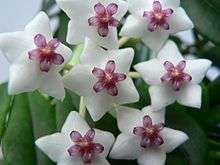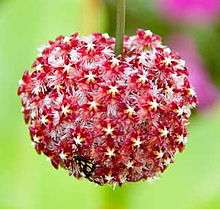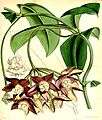Hoya
Hoya is a genus of 200–300 species of tropical plants in the dogbane family, Apocynaceae. Most are native to several countries of Asia such as China, India, Thailand, Malaysia, Vietnam, Bangladesh, and Indonesia. There is a great diversity of species in the Philippines, and species in Polynesia, New Guinea, and Australia.
| Hoya | |
|---|---|
 | |
| Hoya lanceolata ssp. bella | |
| Scientific classification | |
| Kingdom: | Plantae |
| Clade: | Tracheophytes |
| Clade: | Angiosperms |
| Clade: | Eudicots |
| Clade: | Asterids |
| Order: | Gentianales |
| Family: | Apocynaceae |
| Subfamily: | Asclepiadoideae |
| Tribe: | Marsdenieae |
| Genus: | Hoya R.Br. |
| Species | |
|
See text | |
| Synonyms | |
|
Madangia | |
Common names for this genus are waxplant, waxvine, waxflower or simply hoya. This genus was named by botanist Robert Brown, in honour of his friend, botanist Thomas Hoy.[1]
Description
Hoyas are evergreen perennial creepers or vines or rarely, shrubs. They often grow epiphytically on trees; some grow terrestrially, or occasionally in rocky areas. They climb by twining, and with the employment of adventitious roots. Larger species grow 1–18 m (3–59 ft), or more, with suitable support in trees. They have simple entire leaves, arranged in an opposite pattern, that are typically succulent. Leaves may exhibit a variety of forms, and may be smooth, felted or hairy; veination may be prominent or not, and many species have leaf surfaces flecked with irregular small silvery spots.
The flowers appear in axillary umbellate clusters at the tip of peduncles. Hoya peduncles are commonly referred to as spurs. In most species these spurs are perennial and are rarely shed. Each flowering cycle increases the length of the spur, and in the larger species can eventually reach 27 cm (11 in) or more. Flowers vary in size from 3 mm (0.1 in) (Hoya bilobata Schltr.) to over 95 mm (4 in) (in H. lauterbachii K. Schuman) in diameter. Flower form is typically star-shaped, with five thick, waxy, triangular petals, topped with another star-shaped structure, the corona. Colours on most species range from white to pink; there are species that exhibit yellow to orange, dark reds to near-black, and there are green flowers. Many are sweetly scented. and most produce abundant nectar.
Pollinators include moths, flies, and ants. Pollination is poorly understood, but plants left outdoors in temperate regions do sometimes produce seed, indicating pollination by local insects.
Seeds are borne in twin pods, actually follicles, are generally light, and are dispersed by the wind by means of a small tuft of silky fluff. Germination is rapid, but viability is not long.
At least some species exhibit Crassulacean Acid Metabolism (CAM), including H. carnosa.
Several species exhibit adaptations for mutualism with ants by providing modified leaves for domatia ("homes"), much as in the related genus Dischidia; H. imbricata has leaves that form a concave cup over the tree trunk it climbs up to shelter ants, and H. darwinii has arrangements of bullate leaves on its stems to form shelters.
Leaves
Hoya leaves vary in size, texture, colour and venation. In size, leaves range from as small as 5 mm in length and 2 to 4 mm in width (Hoya engleriana Hosseus) to as large as 25 cm by 35 cm. (Hoya latifolia G. Don). Hoya coriacea Blume, has been reported to have leaves as long as two feet in length. There are hoyas with almost perfectly round leaves and others with linear leaves (Hoya linearis Wall. ex. D. Don and Hoya teretifolia Griff. ex Hook. f.). One popular species, Hoya shepherdii Short ex Hook. has leaves that resemble string beans hanging in bunches from their stalks. Hoya linearis Wall. ex D. Don is covered with fine downy hair and resembles masses of Spanish Moss (Tillandsia usneoides) hanging from trees in its native habitat. Some Hoya leaves are smooth and shiny; some are covered with hairs. Some Hoya leaves appear to be veinless while others have very conspicuous veins of a lighter or darker colour than the rest of the leaves as in H. cinnomomifolia. Some have leaves that are mottled with speckles of silvery white (Hoya carnosa R. Br., Hoya pubicalyx). Some hoyas have leaves that are thin and translucent (Hoya coriacea Blume); some are so thick and succulent that they look more like crassulas than hoyas (Hoya australis ssp. rupicola, oramicola and saniae from Australia and Hoya pachyclada from Thailand). One of the most succulent, Hoya kerrii Craib, has obcordate (inverse heart-shaped) leaves, with the cleft away from the stem.
Flowers

Hoya flowers are all shaped like five pointed stars. Some species' petals reflex so far that the flowers appear to be round or ball-like. They grow in umbels, or in some species singly. Umbels can reach impressive proportions in some species, and many species have individual flowers well over three inches in diameter (H. imperialis Lindl., H. lauterbachii K. Schuman). H. coriacea Blume has been known to have as many as 70 in an inflorescence, each individual measuring nearly 2 cm in diameter with the umbels over 30 cm in breadth. The single-flowered Hoya pauciflora Wight makes up for its paucity by its flower size of nearly an inch and a half in diameter produced at any time of year. Textures of flower surfaces may be glabrous and shiny, to matte, to finely haired, and some being quite hairy. One of the two clones of Hoya mindorensis Schltr., from the Philippines, comes very close to being a true red. Blue, purples, and violets do not appear to be represented in the genus Hoya.
Selected species
Species listed here are given in Albers & Meve (2002) and accepted by both The Plant List and Tropicos.
- Hoya archboldiana – Indonesia, Papua New Guinea
- Hoya australis – Australia, Fiji, Indonesia (Irian Jaya), Papua New Guinea, Solomon Islands, Tonga
- Hoya bilobata – Philippines
- Hoya carnosa – S. China, India, Japan, Taiwan, Australia (Queensland), Fiji
- Hoya celebica
- Hoya cinnamomifolia – Indonesia (Java)
- Hoya imbricata – Indonesia (Sulawesi), Philippines
- Hoya kerrii – China, Cambodia, Indonesia (Java), Laos, NW. Thailand, S. Vietnam
- Hoya macgillivrayi – Australia (Queensland)
- Hoya megalaster – Papua New Guinea
- Hoya meliflua – Philippines
- Hoya obscura – Philippines
- Hoya serpens – Australia (Queensland), India (E. Himalaya), Nepal
- Hoya siamica – Cambodia, India, Laos, NW. Thailand, Vietnam
Cultivation and uses
Many species of Hoya are popular houseplants in temperate areas (especially H. carnosa), grown for their attractive foliage and strongly scented flowers. Numerous cultivars have been selected for different leaf forms or flower colours. Hoyas grow well indoors, preferring bright light, but will tolerate fairly low light levels, although they may not flower without bright light. Hoyas commonly sold in nurseries as houseplants include cultivars of H. carnosa (Krimson Queen, Hindu Rope − compacta), H. pubicalyx (often mislabelled as H. carnosa or H. purpurea-fusca), and H. kerrii. Hoyas are easy to propagate, and are commonly sold as cuttings, either rooted or unrooted, or as a potted plant.
Hoya carnosa has been shown in recent studies at the University of Georgia to be an excellent remover of pollutants in the indoor environment. [2]
Various cultures have used hoyas medicinally, especially Polynesian cultures. Some are toxic to livestock and sheep poisonings in Australia are reported.
Several Hoya species and cultivars are excellent terrarium plants.
 Hoya campanulata
Hoya campanulata Hoya cinnamomifolia
Hoya cinnamomifolia Hoya imperialis
Hoya imperialis Hoya parasitica
Hoya parasitica Hoya pottsii
Hoya pottsii
References
- Robert Brown (1810). Prodromus florae Novae Hollandiae et Insulae Van-Diemen, exhibens characteres plantarum quas annis 1802-1805 per oras utriusque insulae collegit et descripsit Robertus Brown; insertis passim aliis speciebus auctori hucusque cognitis, seu evulgatis, seu ineditis, praaesertim Banksianis, in primo itinere navarchi Cook detectis. 1. London: Richard Taylor and Biodiversity Heritage Library. p. 459.
- University of Georgia. UGA research shows some plants can remove indoor pollutants UGA research shows some plants can remove indoor pollutants Check
|url=value (help).
Bibliography
- Albers, F. & Meve, U., eds. (2002), Illustrated Handbook of Succulent Plants: Asclepiadaceae, Springer Verlag, ISBN 978-3-540-41964-8
- Christopher, J.T. & Holtum, J.A.M. (1996), "Patterns of Carbon Partitioning in Leaves of Crassulacean Acid Metabolism Species during Deacidification", Plant Physiology, 112 (1): 393–399, doi:10.1104/pp.112.1.393, PMC 157961, PMID 12226397
- Endress, Mary E. & Bruyns, Peter V. (2000), "A revised classification of the Apocynaceae s.l." (PDF), The Botanical Review, 66 (1): 1–56, doi:10.1007/BF02857781
- Kloppenburg, Dale & Wayman, Ann (2005), The World of Hoyas : a book of pictures (revised ed.), Central Point, OR: Orca Publishing, ISBN 978-0-9630489-4-3
- Liede-Schumann, S. (2006). The Genera of Asclepiadoideae, Secamonoideae and Periplocoideae (Apocynaceae): Descriptions, Illustrations, Identification, and Information Retrieval Version: 21 September 2000.
- Phillips, Roger (1997). The Random House Book of Indoor and Greenhouse Plants (Vol. 2). New York: Random House, Incorporated. ISBN 978-0375750281.
- Trimen, Henry (1888). Hortus Zeylanicus; A Classified List of the Plants, Both Native and Exotic, Growing in the Royal Botanic Gardens. P.R. Deniya. ISBN 9781236067777.
- Yang, Dong Sik; Pennisi, Svoboda V.; Son, Ki-Cheol & Kays, Stanley J. (2009), "Screening Indoor Plants for Volatile Organic Pollutant Removal Efficiency", HortScience, 44 (5): 1377–1381, doi:10.21273/HORTSCI.44.5.1377, retrieved 2011-11-30
- Zachos, Ellen (1997), "Practical Uses of Various Hoya Species"
External links
| Wikispecies has information related to Hoya |
| Wikimedia Commons has media related to Hoya. |
- UGA research shows some plants can remove indoor pollutants December 2, 2009
